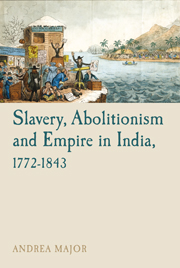Book contents
- Frontmatter
- Contents
- List of Illustrations
- Acknowledgements
- List of Abbreviations
- Glossary
- Some Prominent Figures in the British Parliament, the Abolitionist Movement and the East India Company
- Part I Other Slaveries
- Introduction
- 1 ‘To Call a Slave a Slave’: Recovering Indian Slavery
- Part II European Slaveries
- Part III Indian Slaveries
- Part IV Imagined Slaveries
- Conclusion: ‘Do Justice to India’: Abolitionists and Indian Slavery, 1839–1843
- Select Bibliography
- Index
1 - ‘To Call a Slave a Slave’: Recovering Indian Slavery
from Part I - Other Slaveries
- Frontmatter
- Contents
- List of Illustrations
- Acknowledgements
- List of Abbreviations
- Glossary
- Some Prominent Figures in the British Parliament, the Abolitionist Movement and the East India Company
- Part I Other Slaveries
- Introduction
- 1 ‘To Call a Slave a Slave’: Recovering Indian Slavery
- Part II European Slaveries
- Part III Indian Slaveries
- Part IV Imagined Slaveries
- Conclusion: ‘Do Justice to India’: Abolitionists and Indian Slavery, 1839–1843
- Select Bibliography
- Index
Summary
Walking through the Liverpool International Slavery Museum, one is struck by the force of the commonly accepted master-narrative of British slavery and abolition. The exhibits move seamlessly from idyllic African origins, through capture, the march to the coast and the middle passage, to plantation or domestic labour, abuse, torture, punishment, resistance, abolition and emancipation, before finally concluding with a contemplation of this history's impact on Britain today. It brings this now notorious story alive for the visitor with artefacts, imagery and interactive technologies, yet for an ‘International’ slavery museum the exhibit seems oddly blinkered; all the slaves whose lives it traces are African, and they are all moving west. Other forms of slavery and other slave trades, both throughout history and around the world, are conspicuously absent, silenced by the overwhelming and overpowering horror of the transatlantic trade and New World plantation slavery. By concentrating only on the triangular trade between Europe, Africa and the Americas, the exhibit disconnects the Atlantic from the wider global networks of commerce, capital, labour and migration that characterised the period of European colonial expansion. It also privileges a single archetypal image of slavery characterised by ‘a figure of African descent bending over work in a field of sugar cane or cotton’. This image dominates the popular imagination and, as David Turley notes, provides two starting points for the study of slavery: that those who were enslaved were either racially or culturally alienated outsiders and that they laboured in large-scale agricultural production of staples that were often intended for sale at far-distant markets.
- Type
- Chapter
- Information
- Slavery, Abolitionism and Empire in India, 1772–1843 , pp. 18 - 38Publisher: Liverpool University PressPrint publication year: 2012

